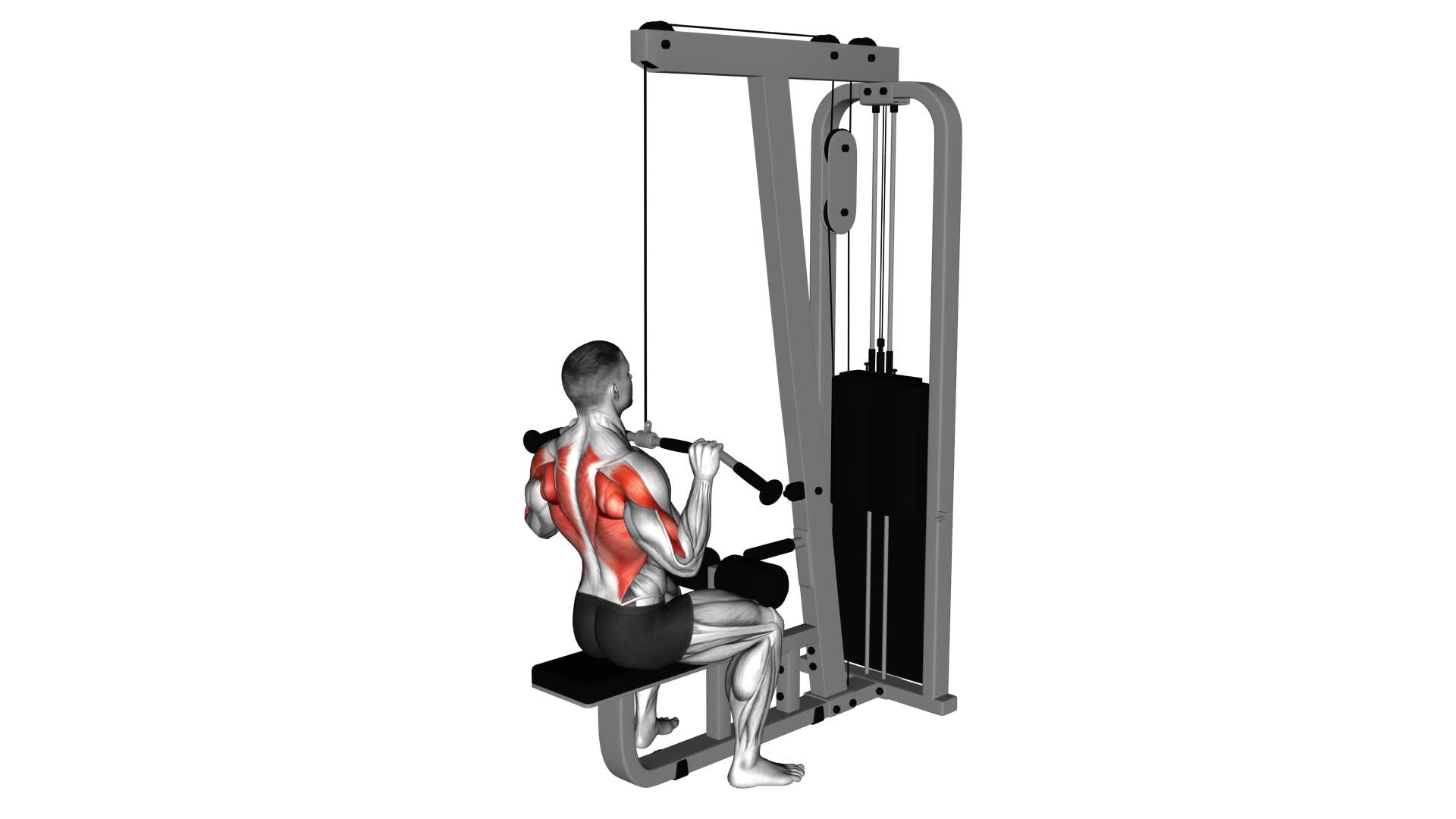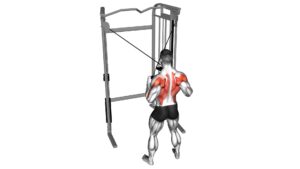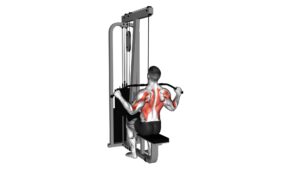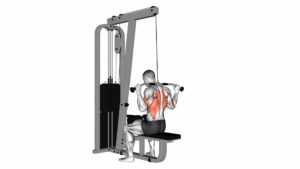Cable Pulldown – Video Exercise Guide & Tips

In this video exercise guide, you'll learn all the tips and tricks you need to master the cable pulldown.
Watch This Exercise Video
We'll show you the proper form and technique to maximize your results.
With different grip variations, you can target specific muscles for a well-rounded workout.
Avoid common mistakes and increase the intensity with our expert tips.
Plus, we'll share safety precautions and injury prevention tips to keep you safe during your workouts.
Get ready to take your cable pulldown game to the next level!
Key Takeaways
- Maintain a stable position and engage core muscles throughout the movement
- Use different grip variations to target different muscles in the back and arms
- Gripping too tightly or using improper hand placement can lead to common grip mistakes
- Avoid using excessive weight and focus on proper breathing and form to prevent injury and maximize effectiveness.
Proper Form and Technique
To perform the cable pulldown exercise correctly, maintain a stable position and engage your core muscles throughout the movement. Proper form and technique are essential to get the most out of this exercise and prevent injuries.
One common form mistake is using too much weight, which causes you to use momentum and not target the intended muscles effectively. To avoid this, start with a weight that allows you to maintain control and perform the exercise with proper form.
Another mistake is leaning back excessively, which takes the emphasis off your back muscles and places strain on your lower back. Instead, keep your torso upright and focus on pulling the bar down towards your chest while squeezing your shoulder blades together.
Additionally, it's important to avoid shrugging your shoulders or using your biceps to pull the bar down. Instead, focus on engaging your lats and using them to initiate the movement.
Grip Variations for Cable Pulldowns
Now let's talk about the benefits of different grip variations for cable pulldowns. By changing your grip, you can target different muscles in your back and arms, helping you achieve a more well-rounded workout.
However, it's important to be aware of common grip mistakes, such as gripping too tightly or using improper hand placement, as these can lead to discomfort or injury.
Benefits of Different Grips
Experience the benefits of different grips for cable pulldowns by incorporating grip variations into your workout routine. By using different hand positions and experimenting with optimal grip width, you can target different muscles and enhance your overall workout.
Changing your grip can shift the emphasis from your back to your biceps or vice versa, allowing for a more balanced development of these muscle groups. For example, a wide grip targets the outer back muscles, while a close grip focuses on the inner back muscles. Additionally, using an underhand grip targets the biceps more effectively.
By varying your grip, you can challenge your muscles in new ways and prevent plateauing.
Now, let's move on to common grip mistakes to avoid for a safe and effective cable pulldown workout.
Common Grip Mistakes
Avoid making the mistake of using improper grip variations for cable pulldowns, as it can hinder the effectiveness of your workout. Here are some common grip issues to be aware of and tips on how to improve grip strength:
- Gripping too tightly: Avoid squeezing the handle too tightly as it can cause unnecessary strain on your forearm muscles. Instead, maintain a firm but relaxed grip.
- Using a narrow grip: Using a narrow grip limits the range of motion and fails to engage the muscles in your back effectively. Opt for a wider grip to target the desired muscle groups.
- Neglecting your thumb: Many people forget to include their thumb in their grip, which can lead to an unstable grip. Make sure to wrap your thumb around the handle for a secure and stable grip.
- Not focusing on grip strength training: To improve your grip strength, incorporate exercises such as farmer's carries, wrist curls, and forearm squeezes into your routine. This will help you maintain a strong grip during cable pulldowns and other exercises.
Common Mistakes to Avoid
When performing cable pulldowns, it's crucial to maintain proper form to avoid injury and maximize effectiveness.
One common mistake to avoid is using excessive weight, as this can lead to poor form and strain on the muscles.
Additionally, it's important to focus on your breathing technique, exhaling during the exertion phase and inhaling during the eccentric phase, to optimize your performance and prevent unnecessary strain.
Proper Form Importance
To ensure optimal results and prevent injury, it's crucial that you maintain proper form while performing cable pulldowns. Here are some common misconceptions about proper form that you should be aware of:
- Importance of warm-up: Many people overlook the importance of warming up before starting their cable pulldown routine. Warm-ups help increase blood flow to the muscles, improve flexibility, and reduce the risk of injury.
- Avoiding rounded shoulders: One common mistake is rounding the shoulders during the exercise. This not only reduces the effectiveness of the workout but also puts unnecessary strain on the shoulder joints.
- Engaging the core: Another misconception is neglecting to engage the core muscles during cable pulldowns. Your core plays a significant role in stabilizing your body and maintaining proper form.
- Full range of motion: Lastly, make sure to perform cable pulldowns through a full range of motion. This means fully extending your arms at the top and squeezing your shoulder blades together at the bottom to engage the targeted muscles effectively.
Avoiding Excessive Weight
Maintaining proper form is crucial when performing cable pulldowns. One common mistake to avoid is using excessive weight. While it may be tempting to load up the machine with heavy weights, doing so can compromise your technique and increase the risk of injury.
It's important to remember that cable pulldowns aren't about lifting the heaviest weight possible, but rather about engaging the right muscles and performing the exercise correctly. By using excessive weight, you may end up relying on momentum or other muscle groups to complete the movement, rather than targeting the intended muscles.
To get the most out of your cable pulldown exercises, focus on using proper weightlifting techniques and maintaining control throughout the entire range of motion. This will ensure that you're effectively targeting the muscles you intend to work.
Now, let's move on to the next section and discuss some breathing technique tips.
Breathing Technique Tips
To maximize the effectiveness of your cable pulldown exercises, it's important to focus on proper breathing techniques and avoid common mistakes. Here are some breathing technique tips and posture correction tips to help you get the most out of your cable pulldown workouts:
- Breathe out during the pulling motion: Exhale as you pull the cable down towards your chest. This helps engage your core and maintain stability.
- Breathe in during the release: Inhale as you slowly release the cable back to the starting position. This allows you to relax your muscles and prepares you for the next repetition.
- Avoid holding your breath: Holding your breath can increase the pressure in your chest and lead to poor form. Remember to breathe continuously throughout the exercise.
- Maintain proper posture: Keep your back straight, shoulders down, and chest lifted throughout the movement. This helps prevent excessive strain on your spine and promotes optimal muscle activation.
Targeting Specific Muscles With Cable Pulldowns
What muscles can you specifically target with cable pulldowns?
Cable pulldowns primarily target the muscles of the upper back, including the latissimus dorsi, rhomboids, and trapezius. These muscles are responsible for pulling your arms down and back, and they play a crucial role in maintaining good posture and upper body strength.
To maximize muscle activation during cable pulldowns, it's important to focus on proper form and technique. Start by sitting upright with your feet flat on the ground, knees bent, and your core engaged. Grab the cable bar with an overhand grip, slightly wider than shoulder-width apart. As you pull the bar down towards your chest, focus on squeezing your shoulder blades together and engaging your back muscles. Slowly return the bar to the starting position, maintaining control throughout the movement.
To target different areas of the back, you can modify the grip and hand placement. By using a wide grip, you can emphasize the outer portion of your lats, while a narrow grip will target the middle portion. Additionally, using an underhand grip will shift the focus to your biceps and lower lats.
Incorporating exercise variations like the single-arm cable pulldown or the kneeling cable pulldown can further isolate specific muscles and add variety to your workouts. Remember to always start with lighter weights and gradually increase the resistance as your strength improves.
Tips for Increasing Intensity and Progression
Looking to increase the intensity and progression of your cable pulldown workout? Here are some tips to help you achieve your goals:
- Increase Resistance: Gradually increase the weight you use for cable pulldowns to challenge your muscles and promote growth. Start with a weight that allows you to perform 8-12 reps with proper form, and then gradually increase the resistance as you get stronger.
- Use Advanced Variations: Once you have mastered the basic cable pulldown, try incorporating advanced variations to further challenge your muscles. Some examples include the wide-grip pulldown, close-grip pulldown, and one-arm pulldown. These variations target different muscles and can help you break through plateaus.
- Focus on Tempo: To increase the intensity of your cable pulldown workout, pay attention to your tempo. Slow down the eccentric (lowering) phase of the movement and pause at the bottom before exploding back up. This will increase time under tension and make your muscles work harder.
- Incorporate Drop Sets: To push your muscles to their limits, try incorporating drop sets into your cable pulldown routine. Start with a heavy weight and perform as many reps as you can. Then, immediately decrease the weight and continue until failure. This technique helps to exhaust the muscles and promote muscle growth.
Safety Precautions and Injury Prevention Tips
Did you know that there are important safety precautions and injury prevention tips to keep in mind when performing cable pulldowns? To ensure your safety during this exercise, it's essential to follow these safety rules.
First, always use the appropriate weight for your fitness level and avoid lifting more than you can handle. This will help prevent strain or injury to your muscles and joints.
Additionally, make sure to maintain proper form throughout the exercise. Keep your back straight, shoulders down, and engage your core to protect your spine.
It's also crucial to warm up before starting cable pulldowns. This can be done through dynamic stretches or light cardio exercises to increase blood flow and prepare your muscles for the workout.
Lastly, listen to your body and take breaks if needed. Pushing through pain or fatigue can lead to injury, so it's important to rest and recover when necessary.
Frequently Asked Questions
Is Cable Pulldown a Suitable Exercise for Beginners?
Yes, cable pulldown is a suitable exercise for beginners. It provides several benefits such as strengthening your back muscles and improving overall upper body strength.
However, there are common mistakes to avoid. Make sure to use proper form, keep your back straight, and avoid using too much weight. Starting with lighter weights and gradually increasing intensity will help you build strength safely.
How Often Should Cable Pulldowns Be Performed for Optimal Results?
To get optimal results from cable pulldowns, it's important to perform them properly. Make sure you have the right form and technique. Avoid common mistakes like using too much weight or relying on momentum.
It's recommended to do cable pulldowns 2-3 times a week, allowing your muscles to recover in between sessions. Consistency is key, so stick to a regular schedule and gradually increase the intensity as you progress.
Can Cable Pulldowns Help Improve Posture?
Cable pulldowns are a great exercise for improving posture. By targeting the muscles in your upper back and shoulders, they can help strengthen and stabilize your spine, leading to better posture.
Unlike pull-ups, cable pulldowns allow for more controlled and adjustable resistance, making them suitable for all fitness levels.
Incorporating cable pulldowns into your workout routine can provide you with the benefits of improved posture and a stronger upper body.
Are There Any Alternative Exercises That Can Target the Same Muscles as Cable Pulldowns?
Looking for alternative exercises to target the same muscles as cable pulldowns? There are a few options you can try.
One option is the lat pulldown machine, which works similar muscles.
Another option is the bent-over row, which targets the back muscles as well.
You can also try doing pull-ups or chin-ups, which engage the same muscle groups.
Remember to focus on proper form and technique to get the most out of these exercises.
Can Cable Pulldowns Be Performed With a Resistance Band Instead of a Cable Machine?
Yes, cable pulldowns can be performed with a resistance band instead of a cable machine. Using a resistance band for cable pulldowns offers several benefits.
It allows for a wider range of motion and provides constant tension throughout the movement. Additionally, resistance bands are portable and can be used anywhere, making them a convenient alternative to cable machines.
Conclusion
In conclusion, cable pulldowns are a great exercise for targeting and strengthening the muscles in your back, shoulders, and arms.
By maintaining proper form and technique, using different grip variations, and avoiding common mistakes, you can maximize the effectiveness of this exercise.
Additionally, gradually increasing intensity and progression will help you continue to challenge your muscles and make progress.
Remember to prioritize safety and follow injury prevention tips to ensure a safe and effective workout.

Author
Years ago, the spark of my life’s passion ignited in my mind the moment I stepped into the local gym for the first time. The inaugural bead of perspiration, the initial endeavor, the very first surge of endorphins, and a sense of pride that washed over me post-workout marked the beginning of my deep-seated interest in strength sports, fitness, and sports nutrition. This very curiosity blossomed rapidly into a profound fascination, propelling me to earn a Master’s degree in Physical Education from the Academy of Physical Education in Krakow, followed by a Sports Manager diploma from the Jagiellonian University. My journey of growth led me to gain more specialized qualifications, such as being a certified personal trainer with a focus on sports dietetics, a lifeguard, and an instructor for wellness and corrective gymnastics. Theoretical knowledge paired seamlessly with practical experience, reinforcing my belief that the transformation of individuals under my guidance was also a reflection of my personal growth. This belief holds true even today. Each day, I strive to push the boundaries and explore new realms. These realms gently elevate me to greater heights. The unique combination of passion for my field and the continuous quest for growth fuels my drive to break new ground.



